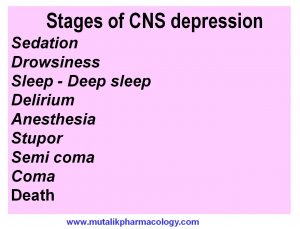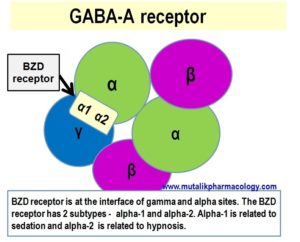Sedative-Hypnotic Drugs
Sedative-Hypnotic is a combined word indicating the degree of central nervous system (CNS) depression. Sedative-Hypnotic drugs are are also referred to as Hypno-Sedative drugs.
Sedation means calming or quietening or decreasing excitement (without inducing sleep).
Hypnosis means sleep like natural sleep. Hypnotics induce or maintain sleep which is somewhat like natural sleep.
Sedation and Hypnosis are just the two stages of CNS depression in an increasing order.
A drug given in lower dose may produce sedation. The same drug in an increased dose may produce hypnosis.
In case of a person who follows a normal work schedule of working during the day and sleeping at night, a drug may produce only sedation when given in the morning (because the central nervous system is very alert in the morning); whereas the same drug may produce hypnosis (sleep) when given at night.
In other words, a small dose of the drug may be enough to produce hypnosis if the drug is given in the evening; whereas the same drug when given in the morning may be needed in much higher dose to produce hypnosis.
SAQ/Viva
Mention the various stages of CNS depression in an increasing order.
SAQ/Viva
What is sedation and what is hypnosis?
Sedation and Hypnosis are both, the stages in central nervous system depression.
Sedation means calming or quietening or decreasing excitement (without inducing sleep).
Hypnosis means sleep like natural sleep. Hypnotics induce or maintain sleep which is somewhat like natural sleep.
LAQ/SAQ/Viva
Classify Sedative-Hypnotic drugs with examples.
1. Benzodiazepines
- Hypnotic: diazepam, flurazepam, nitrazepam, temazepam, alprazolam, triazolam
- Antianxiety: diazepam, chlordiazepoxide, oxazepam, lorazepam, alprazolam
- Antiseizure: diazepam, lorazepam (to stop convulsions), clonazepam, nitrazepam, chlorazepate dipotassium, clobazam (petit mal, myoclonic, infantile spasm)
2. Non-Bensodiazepines: (Only Hypnotic; Not for anxiety): Zolpiclone, Zolpidem, Zaleplon [Z drugs]
3. Melatonin, Ramelteon (Melatonin Receptor Agonist): (Useful in sleep disturbances in shift workers, and due to jet lag)
4. Barbiturates: Phenobarbitone, Amylobarbitone
5. Traditional/Classical/1st Generation Antihistamines: Hydroxyzine, Diphenhydramine, Chlorpheniramine, Doxylamine
6. Ethyl alcohol
7. Opiates: Morphine, Pethidine, Pentazocine
8. Others: Chloral hydrate, paraldehyde, bromides, meprobamate, antipsychotics, antidepressants
SAQ/Viva/LAQ
Compare and Contrast: Barbiturates Vs Benzodiazepines
They
Barbiturates |
Benzodiazepines |
| Low Therapeutic Index – less safe | Better Therapeutic index than barbiturates (Safer than barbiturates) |
| High Abuse / dependence liability and physical dependence | Less than barbiturates |
| More Respiratory and CVS depression | Less respiratory and cardiovascular depression |
| They disrupt REM-nREM sleep cycles and disrupt sleep architecture | Comparatively Less disruption of sleep architecture.
As compared to barbiturates, the sleep is closer to normal sleep. |
| More Hangover.
Sleep is less refreshing |
Hangover is less than barbiturates.
Sleep is more refreshing. |
| Increase sleep duration,
Decrease sleep latency, Less awakenings during the sleep |
All effects on components of sleep are better than barbiturates. |
| Decrease the REM sleep
Decrease Stage 3,4 sleep |
Decrease REM sleep
Decrease Stage 3,4 sleep Increase Stage 2 sleep |
| REM rebound on abrupt stoppage is — more severe. | REM rebound on abrupt stoppage is Less severe. |
| Anterograde amnesia + + +
Drug automatism + + + |
Yes, but less severe
Yes, but less severe |
| Skeletal Muscle Relaxation – Yes | Skeletal muscle relaxation is BETTER and happens at lesser doses |
| No specific antianxiety effect | Specific anxiolytic effect |
| Induction of CYP3A4 (Hepatic Microsomal Enzyme System}
C/I: Acute Intermittent Porphyria |
Less induction as compared to barbiturates |
| Drug interactions +++++
Inducers of CYP450 enzymes |
Less drug interactions |
| Can lead to contraceptive failure due to induction of metabolism of oral contraceptives | Same as barbiturates |
| No specific antagonist
Acute barbiturate poisoning needs Forced alkaline diuresis, Intravenous NaHCO3, hemodialysis |
Competitive antagonist is available – Flumazenil |
SAQ/Viva/LAQ
Mention pharmacological actions of Benzodiazepines.
1. Sedation, hypnosis
- Decrease sleep latency
- Decrease night awakenings
- Increase sleep duration
- Increase stage 2 sleep
- Decrease stage 3, 4 sleep and REM sleep
- Movements and night terrors reduced
- Less hangover as compared to barbiturates
- More refreshing sleep as compared to barbiturates
2. Anterograde amnesia
3. Limbic system – Selective anxiolytic action –independent of CNS depression
4. Anticonvulsant action – stop convulsions (due to most of the causes)
5. Skeletal muscle relaxation – (Central action) – clonazepam, diazepam
6. Decrease the blood pressure, produce myocardial suppression
7. Respiratory depression
8. Decrease the noctural HCl secretion from the stomach (may be useful to prevent stress ulcers)
SAQ/Viva
Mention mechanism of action of Benzodiazepines.
Benzodiazepines combine with GABA-A receptor. GABA-A receptor is an ion channel gated receptor, which on activation results into entry of Chloride ions
On the GABA-A receptor, the place where benzodiazepines combine is the interface of Alpha and Gamma sites on the GABA-A receptor. (This place is also called Benzodiazepine receptor) (BZD receptor). BZD receptor has 2 sites named alpha-1 and alpha-2. Alpha-1 is responsible for sedative-hypnotic action, and alpha-2 is responsible for specific anti-anxiety action.
Benzodiazepines increase the action of GABA. It is agonist-like action on the GABA-A receptor.
Activation of this receptor increases the entry of chloride channels.
Benzodiazepines increase the frequency of chloride channel opening.
Since GABA is inhibitor in nature, activation of GABA leads to central nervous system depression.
The pentameric (5 components) structure of the GABA receptor and the site of action of benzodiazepines is shown below.

SAQ/Viva
Enumerate adverse effects of benzodiazepines.
1. Dose-dependent Central Nervous System Depression
2. Drowiness, Hangover, Dizziness, Vertigo, Ataxia
3. Anterograde Amnesia
4. Impaired psychomotor skills
5. Respiratory depression, apnea
6. Hypotension
7. Tolerance, Psychological as well as physical dependence
8. REM rebound sleep/anxiety/sleeplessness on abrupt withdrawal after long term use
8. Acute overdose /toxicity: This is treated with FLUMAZENIL which is a competitive antagonist at BZD receptor.
SAQ/Viva
What is REM rebound?
There are in general 2 types of sleep: REM (Rapid Eye Movement) Sleep and n-REM (Non Rapid Eye Movement) sleep.
- Most sedative-hypnotics when used for long time for treatment of insomnia, suppress the REM sleep….
- So, when these drugs are stopped after long-term use, there is increase in the REM sleep.
- This is called REM rebound.
LAQ/SAQ/Viva
Mention uses of Sedative-Hypnotic Drugs
(Please remember that while mentioning the uses of these drugs, first we should mention the uses related to sedative and hypnotic actions. Later we can mention the uses pertaining to some other actions of these drugs – for example, Benzodiazepines are used to stop convulsions; but since this is their anticonvulsant action and not related to sedative hypnotic action – such uses should be mentioned later with a separate category)
(So also, the most common and therapeutically effective Sedative Hypnotics include -Benzodiazepines, -Nonbenzodiazepines, and -Melatonin or Ramelteon).
- To assist short procedures: Examples: Electroversion, catherization, ECT, endoscopies, obstetric and minor procedures
- Preanesthetic medication for Sedation before anesthesia
- Post-operative sedation
- Treatment of drug withdrawal states and management of addiction (chlordiazepoxide, chlorazepate, diazepam, oxazepam) (Useful due to Sedative Hypnotic actions as well as anticonvulsant actions)
- Treatment of alcohol withdrawal: (Useful due to Sedative Hypnotic actions as well as anticonvulsant actions)
- Anxiety states: Acute situations like Phobia, Panic states, and also in Generalized Anxiety Disorders, Post-traumatic stress disorder – Usually Benzodiazepines
- Insomnia and Night terrors: Non-benzodiazepines (Z drugs such as Zaleplon, Zopiclone, and Zolpidem – preferred due to their predominant hypnotic action and less abuse liability) and (Benzodiazepines such as Diazepam, Lorazepam, Alprazolam, Chlordiazepoxide, Flurazepam, Temazepam, Triazolam)
- Conscious sedation (allowing the person to be receptive to instructions during procedures) (example: Midazolam)
- As INTRAVENOUS anesthetics (a benzodiazepine – Diazepam for slow action and a barbiturate – Thiopental sodium for rapid action)
- To stop the convulsions (as Anticonvulsant) for convulsions due to status epilepticus, febrile convulsions, tetanus, drug withdrawal seizures -Lorazepam, diazepam (Intravenous)
- Centrally acting muscle relaxant (Benzodiazepines): Spastic disorders, acute muscle spasms, orthopedic procedures
- Absence seizures (Petit mal), myoclonic, infantile spasm: Clonazepam, clobazam, chlorazepate di-K, nitrazepam
- Alongwith analgesics, NSAIDs, spasmolytics, antiulcer agents (Helpful to decreases HCl secretion, useful in stress ulcers)
SAQ/Viva
Enumerate Non-Benzodiazepines. / Enumerate Z drugs. Mention their advantages.
Non-benzodiazepines: Zopiclone, Zolpidem, Zaleplon
Useful to treat insomina (and not anxiety): They have only hypnotic action; and no specific anxiolytic effect.
BZD receptor is the interface of Alpha and Gama site.
The BZD receptor has 2 sites: Alpha -1 site responsible for hypnotic action ; and Alpha -2 site is responsible for anxiolytic action. NONBENZODIAZEPINES HAVE SELECTIVE ACTION ONLY ON ALPHA-1 SITE; so they lead to only hypnotic effect, and hence useful only in the treatment of insomina, and not useful to treat anxiety.
ADVANTAGES:
- Minimal REM suppression,
- iNCREASE stage 3, and 4 sleep
- DECREASE sleep latency
- Less disturbed sleep architecture
- Less hangover
- Less abuse potential
- Minimal tolerance
- Minimal physical dependence (Withdrawal less severe)
Sir can you please tell me therapeutic effects of benzodiazepines?
Central Nervous System Depreesion
Sedation, Hypnosis, Anxiolytic (Antianxiety action), Centrally acting muscle relasant effect, Antiseizure effect (Useful anticonvulsant action in emergency to stop the convulsions and prophylactic use in certain types of epilepsy)